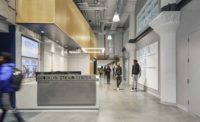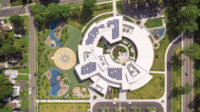You know exactly where you are when you walk through the newly opened Avenues: The World School. There are spectacular views of Manhattan at all levels and from just about every space in the 1928 former warehouse designed by Cass Gilbert for the R.C. Williams Company, a grocery wholesaler. The skyline, the High Line park, and the bustling, gritty streets of West Chelsea are at its doorstep, providing just the type of contextual setting the school's three founders, its leadership council, and the design team had in mind when they selected the 10-story, poured-in-place-concrete structure as the first of 20 international campuses they plan to roll out over the next 10 or more years.
According to Avenues' chief facilities officer, architect Raymond Bordwell, each facility will reflect its location, whether that is New York City, or Beijing or S'o Paulo (the next two campuses, both scheduled to open in 2015). There will be similar programmatic elements, however. Developed with a corporate-like approach, the privately funded institution aims to provide real-world experiences for its pre-kindergarten through 12th-grade students. The curriculum revolves around self-directed, project-based learning with a multinational emphasis that includes language immersion. New York students spend half their day in English-speaking classrooms and the other half learning and attending classes in either Mandarin or Spanish. Eventually, children and teachers will interact with other Avenues campuses via distance-classroom cameras and foreign-exchange programs.
Bordwell collaborated with Perkins Eastman and the New York'based design firm Bonetti/Kozerski Studio to create a flexible core-and-shell model that would loosely translate to other locations and architectural styles. Delivered empty and in sound condition after its most recent stint storing soap-opera costumes and sets, the existing 215,000-square-foot warehouse required a complete overhaul.
Occupying one full block on 10th Avenue between 25th and 26th Streets, the building is categorized as a contributing property within a historic district. After obtaining the necessary permissions, the design team gutted the building down to its substantial columns, 12-inch-thick concrete shell, and 11-inch-thick slabs, replacing the windows with operable double-glazed units and insulating the walls and ceilings for noise protection and energy efficiency. They replaced two central stairs with new stairways in three corner locations; swapped out two large freight elevators for four passenger-size destination-dispatch versions; and raised the roof on a section of the top floor to create a double-height gym. Then they expanded the sidewalk out front by transforming the loading docks into a portico with recessed glazing and a new entrance that leads visitors into the main lobby'an elegantly tiled space that immediately treats them to glimpses of the High Line at the top of a grand, processional stair. A second entrance and lobby on the side street provide secure, private access to the Early Learning Center.
The tile continues around the core throughout the upper levels, where the designers took advantage of the building's two-way slab construction by slicing through intermediary floors to create open, dual-level spaces within distinct lower-, middle-, and high-schools-within-a-school. 'Since it is a vertical school, we wanted to connect the floors in different areas with a visual link,' says Perkins Eastman principal Christine Schlendorf. Unimpeded east and west window banks, supplemented by clerestories along perimeter classroom walls on the north and south sides, infuse internal study and library common areas and glass-enclosed project rooms with daylight. State-of-the-art digital learning and communication tools, and the use of such classic materials as marble and wood, balance tradition and innovation. At the same time, 'we exposed as much as possible of the old building to retain the industrial quality,' says interior designer Enrico Bonetti.
The school's architecture and mission have struck a chord. Despite a steep $40,000-per-year tuition, the New York campus attracted over 700 inaugural students through grade nine, and can accept more than 1,600 as the upper grades populate. Inherently adaptable by design, Avenues offers alternate paths to consider for all urban schools.
Completion Date: September 2012
Gross square footage: 215,000 square feet
Total construction cost: $60 million
PeopleOwner: Avenues: The World School
Architect:
Personnel in architect's firm who should receive special credit:
Interior designer:
Personnel in interior designer’s firm who should receive special credit:
Engineers:
Consultant(s):
Photographer(s): CAD system, project management, or other software used: Revit |
Products
Structural system Windows: Skyline Accoustical Windows: St. Cloud
Doors
Hardware
Interior finishes
Suspension grid: Armstrong Interlude Kitchen: Flick Marble: White marble counters at kitchen and bathroom Millwork: Mensch Lab Casework: Diversified Casework Paints and stains: Benjamin Moore Plastic laminate: Abet Laminati (on lockers) Floor and wall tile:
Rubber Floor at Fitness: Prialpas Resilient flooring: Dur-A-Gard Epoxy floor by Dur-A-Flex (ground, 2nd & 3rd floors) Carpet: Fine-tuned modular tiles by Bolyu Contract Raised flooring: Kahrs (dance floor); Connor Sports Flooring “GreenPlay” (gym) Special interior finishes unique to this project:
Furnishings Reception furniture: see “other furniture” below Fixed seating: see “other furniture” below Chairs—classroom chairs: Novex and VS Tables—classroom tables: VS and Howe, at Suite NY Other furniture:
Lighting Downlights: Spectrum Classroom Linear Pendant: Picasso Pendant Fixture in commons café: BTC Interior Ambient lighting in elevator lobbies: VIA BIZZUNO Exterior: Jesco and Luminaire
Conveyance
Add any additional building components or spsecial equipment that made a significant contribution to this project: Graphics: Environmental Graphics throughout building by Susan Hochbaum, Andy Clayman (Avenues’ creative director), and Bonetti/Kozerski Studio. Installation by Coloredge, New York |















Post a comment to this article
Report Abusive Comment